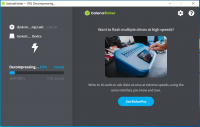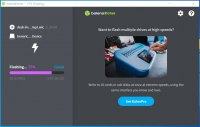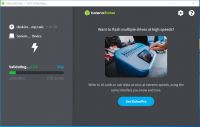Template:How to create a bootable SD card
| History | |||
|---|---|---|---|
| Issue Date | Notes | ||
| TBD | |||
| Year/Month/Day | TBD | ||
Contents
How to create a bootable SD card[edit source]
This article shows how to (re)create the bootable SD card, from the binary images produced by the DESK-MX-L Yocto build, using a standard SD image flasher like balenaEtcher
The process is relatively straightforward: it consists of writing the WIC file of interest generated by Yocto onto the SD card. The following instruction explains how to use balenaEtcher on a Windows host. The procedure is similar when working with a Linux host.
- download the desired binary image to flash (
*.wicor*.wic.bz2) from the mirror binary server selecting the proper DESK-MXxx-L release- among the binaries made available in the mirror there are several
*.wic.bz2files for the available releases. In particular, there is thedave-image-devel-desk-mxXXXX.wic.bz2(for {{{nome-som}}}) file. This image is the one used to program the microSD card delivered along with the evaluation kit.
- among the binaries made available in the mirror there are several
- connect the microSD card to the PC Host
- open balenaEtcher tool
- once the tool is open:
- select the binary to flash by clicking on
Flash from file - select the microSD to flash by clicking on
Select target - flash the uSD by clicking o
Flash
- select the binary to flash by clicking on
SD card structure[edit source]
The created SD card has the following structure:
- raw sectors for the bootloader storage: tipically this is a 8MB raw part where storing the bootloader binaries (like
imxXXX_flash.bin) for the bootrom startup FAT32first partition: this will be mapped to the/dev/mmcblkXp1device in Linux- usually this partition contains the Linux kernel binary and the device tree blob
- the splash screen image is stored in this partition too for a splash image showing during U-Boot startup
ext4second partition: this will be mapped to the/dev/mmcblkXp2device in Linux- this partition contains the Linux root file system
Creating the SD card from binary artifacts[edit source]
Even if the overall binary artifacts have been created by the Yocto build, it is highly discouraged to manually create the SD card starting from them.
The Yocto build take care about the overall binary consistance (like kernel modules and so on) avoiding to mistmatch different version.
Moreover, the SD card is intended to be used during the development process and not for the production phase (where other deployment specifications and details have to be taken into account).
[[Category:{{{nome-som}}}]]


